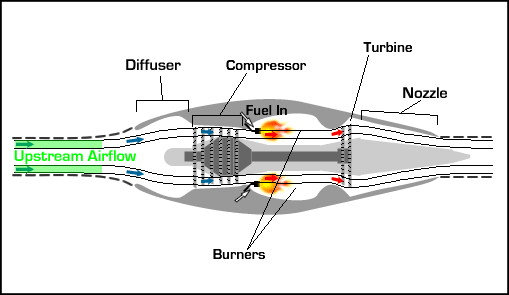
Messerschmidt Me 262.
Photographed by U.S. Air Force.
Jet engines are used to propel commercial airliners and military aircraft. The simplest version of aircraft jet engines is a turbojet. Turbojets were used on the first jet powered aircraft, the German Messerschmidt Me 262 used in World War II.

Turbojets tend to be inefficient except at high speeds, so modern aircraft use turbofans instead. Since the basic operation of a turbojet is simpler, we will begin our discussion of jet engines with turbojets.
The main components of a turbojet are shown in the animation below. In a turbojet engine, energy is added to the air by the compressor and burners. The compressor increases the pressure of the air analogous to the way squid pressurize water with their powerful muscles before ejecting it from their funnel to create a jet. The burners increase the temperature of the air. The result is high temperature, high pressure air that contains a lot of thermal energy. Some of this energy is extracted by the turbine to run the compressor. The rest is converted to kinetic energy as it is accelerated by the nozzle to a high velocity to generate thrust. Use the arrows in the interactive animation below to step through descriptions of the different components and obtain more detailed information about their operation.
 |
|
 |
|
 |
 |
Although both propellers and turbojets involve spinning components and accelerate fluid to generate propulsion, their internal operation is quite different. First, whereas a propeller adds energy to the fluid by accelerating it with the propeller blades, a turbojet adds energy by compressing it to a high pressure with the compressor. The compressor is really a series of spinning and stationary blades. The spinning blades accelerate the air (like a propeller) and the stationary blades slow it down again, which converts the kinetic energy of the air to pressure. Second, nearly all of the fuel energy used by an engine driving a propeller is used to spin the propeller, but only a fraction of the fuel energy used in a turbojet is harnessed by the turbine to drive the compressor. Third, a propeller accelerates the fluid with its blades, but fluid acceleration in a turbojet is accomplished by the nozzle, not the compressor blades.
The thrust developed by a turbojet can be computed from  (see the description of thrust in the Principles section). For the turbojets it is possible to have pe ≠ p0, but this is not the optimal condition and most designs try to achieve
(see the description of thrust in the Principles section). For the turbojets it is possible to have pe ≠ p0, but this is not the optimal condition and most designs try to achieve  . As with propeller propulsion,
. As with propeller propulsion,  can be increased by increasing the engine size (diameter) or by increasing the compressor speed. Increasing the compressor speed requires more fuel input in order to turn the turbine faster. The net acceleration of the air though the engine, Ve - V0, can be increased by increasing the amount by which the air is compressed (the compression ratio of the compressor) or the temperature of the air in the burners. Increasing the air temperature can be accomplished by burning more fuel, but only up to a point. If the temperature is raised too much, it will melt the turbine blades! Some engine designs add additional control over Ve - V0 by adding a variable geometry nozzle. Variable geometry allows the fluid acceleration through the nozzle to be optimized for the given engine settings and flying conditions. Such features allow the exit velocity, Ve, achieved by jet engines to be much higher than that produced by a propeller.
can be increased by increasing the engine size (diameter) or by increasing the compressor speed. Increasing the compressor speed requires more fuel input in order to turn the turbine faster. The net acceleration of the air though the engine, Ve - V0, can be increased by increasing the amount by which the air is compressed (the compression ratio of the compressor) or the temperature of the air in the burners. Increasing the air temperature can be accomplished by burning more fuel, but only up to a point. If the temperature is raised too much, it will melt the turbine blades! Some engine designs add additional control over Ve - V0 by adding a variable geometry nozzle. Variable geometry allows the fluid acceleration through the nozzle to be optimized for the given engine settings and flying conditions. Such features allow the exit velocity, Ve, achieved by jet engines to be much higher than that produced by a propeller.
An additional feature added to some jet engines is an afterburner. An afterburner injects fuel into the flow immediately after the turbine.

The extra fuel burns, adding extra thermal energy to the air and increasing the jet exit velocity, Ve. The extra thrust provided gives an extra "kick" at the expense of expended fuel. Afterburners are common on military aircraft for situations where a sudden burst of speed is required.
Because of the large jet velocity than can be achieved, turbojets generate large thrust and can be used to propel aircraft to high velocities. The large jet velocity also makes them inefficient at low aircraft velocities, in large part because a large Ve - V0 leads to low propulsive efficiency. Propulsive efficiency of turbojets increases as the aircraft velocity increases, but the aircraft typically must be supersonic before turbojet propulsive efficiencies approach levels that can compete with propellers.
|
|
